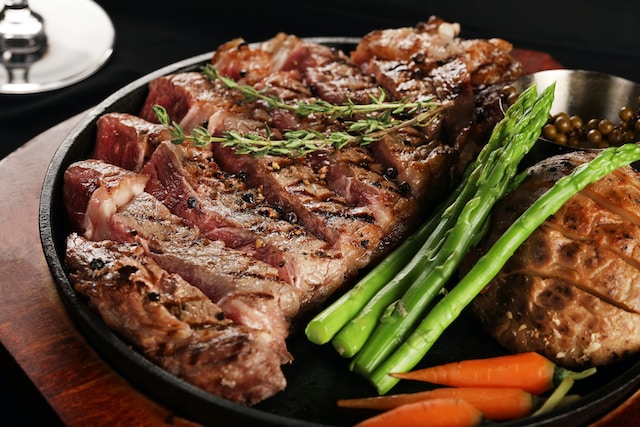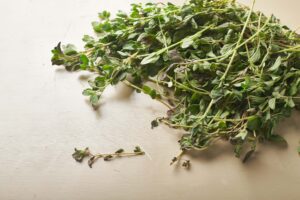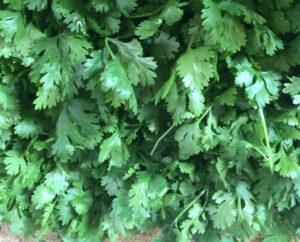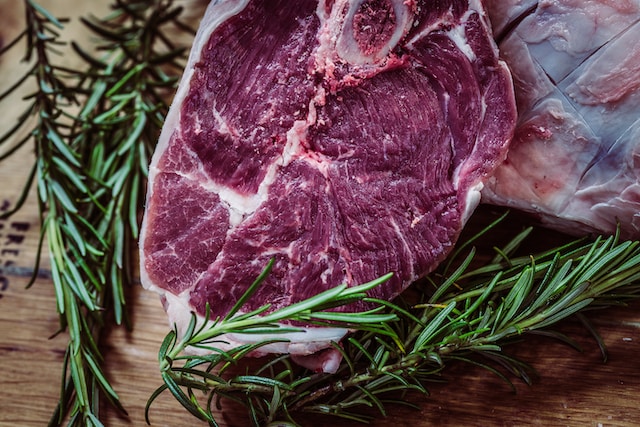For those who enjoy meat, beef can provide a delectable and gratifying protein source. But have you ever thought of the idea of using herbs to intensify your preferred beef meals? Harnessing the power of herbs may grant an enriched dimension to your dishes and elevate them beyond expectation. Herbs are more than just a flavor enhancer, as they possess several health advantages that make them an excellent supplement to any dish.
This post will delve into various herbs suitable for beef and explain how you can integrate these herbs into your cooking to achieve optimal taste and nutrition. Regardless of whether you’re barbecuing steak or stewing tenderloin, our selection of herbal recipes is sure to gratify your palate with bursts of flavors. Come along with us on this exciting journey through the world of incorporating herbaceous elements in every meal!
Importance Of Herbs On Seasoning Beef

The incorporation of herbs into the seasoning of beef is crucial. This is because it provides numerous advantages that boost both the flavor and health benefits.
To begin with, relying solely on salt or pepper to season your meat cannot produce a rich taste profile comparable to adding an array of herbs. Overlaying distinct flavors onto the naturally savory taste found in beef can elevate its overall deliciousness level immensely.
Furthermore, the scent of herbs is capable of enhancing beef’s fragrance entirely. This happens due to the dispelling of aromatic oils within them that intertwine with meat when heated and produce an enjoyable aroma. Moreover, these herbs have chromatic properties too by generating variation in color for beef dishes.
In short, the bountiful array of nutrients and antioxidants contained within herbs can be advantageous to our well-being. By incorporating a diverse selection of these plant-based ingredients when flavoring beef dishes, you have the potential to concoct delectable meals that will appeal not only to your loved ones but also nourish their health.
Best Herbs To Season Beef
✓ Rosemary

Rosemary, an herb popular for its exquisite fragrance and flavor, is often present in Mediterranean dishes. The rich taste of rosemary perfectly complements beef dishes such as roasted meats or grilled steaks. The leaves of the plant are hardy. Hence, they require being chopped finely before use to release their unique aroma fully. When combined with other strong seasonings like garlic, thyme, or black pepper, this herb adds new dimensions to classic meat recipes.
Rosemary boasts a range of health advantages. Its possession of free radical-combating antioxidants is one such advantage. Additionally, it has been revealed to enhance cognitive function and promote digestion. For years, conventional medicine practitioners have employed rosemary in the treatment of diverse illnesses like arthritis pain relief techniques, indigestion solutions as well as migraine cures.
Incorporating rosemary into dishes requires one’s discretion since its robust taste can easily dominate the other ingredients. You may use either fresh or dried variants of it. Its flavor is best enjoyed when added early during cooking so that ample time for immersion in the dish has been given to fully extract all flavors from this herb.
✓ Thyme

The thyme herb is an adaptable and multipurpose plant that typically graces dishes in French and Mediterranean cooking. Its distinctly sweet yet earthy profile makes it a splendid garnish for beef-based meals, such as stew or pot roast cuisine options. Furthermore, this ubiquitous herb has found its way into marinades as well as spice rubs. This intends to enhance the flavors of various types of meat including those derived from cows.
Thyme is a herb that boasts various health advantages. Its antioxidant properties shield from the development of ailments like cancer while also providing vitamins C and A, along with iron, calcium, and manganese to maintain one’s physical well-being. Additionally, thyme is popular for its antibacterial and antifungal abilities.
When incorporating thyme into dishes, you should bear in mind that a small amount is potent enough for the entire meal. Its prominent taste can quickly dominate other components. Thus, it’s best to be frugal with usage. Although fresh thyme triumphs over dried ones, both types suffice as ingredients. Adding this herb at an early stage of cooking or tossing some on top once completed will enhance its overall flavor and aesthetics respectively.
✓ Sage

The sage herb has a spicy taste that is frequently applied in Italian cooking. It complements beef dishes with strong attributes like onions, or other sharp flavors flawlessly. You are free to use sage either fresh or dried. It can be sliced into small minces before combining it throughout your cuisine. Like many herbs, sage possesses various health benefits. Some benefits include being richly high in antioxidants and enhancing cognitive function. When ingested regularly, it can be extremely effective at treating numerous ailments such as severe indigestion problems terrible sore throats, and even symptoms related to depression-like states of mind!
It is wise to exercise caution when using sage in meals to avoid drowning the other ingredients since its potent taste could easily overwhelm them. Fresh and dried options of sage are both viable choices. You can add it right away as they begin cooking or sprinkle a bit on top once finished for an attractive touch.
✓ Oregano

A well-loved herb in Greek and Italian cooking, oregano boasts a savory taste that tickles the palate. Its sharp edge meshes exceedingly with beef’s richness, making it an exceptional pick for marinades or seasonings.
People can add minced or chopped leaves of either fresh or dried varieties into their dishes according to preference. Furthermore, this plant is widely renowned for its numerous health benefits. It’s enriched with antioxidants while also harboring antibacterial and antifungal properties. These have earned oregano therapeutic acclaim throughout history by treating coughs as well as digestion problems among other things.
While using oregano in cuisine, it is paramount to exercise caution and use the herb sparingly. Its potent flavor has a tendency of dominating other constituents with ease. The utilization of fresh oregano remains optimal, but dried versions can serve as adequate alternatives whenever necessary. Early infusion into dishes during their cooking process enables their flavors to harmonize with that of all other components effectively enough for an outstanding meal experience ultimately.
✓ Bay leaves

The bay leaves possess an unobtrusive taste that enhances soups and stews made with beef. They frequently feature in Mediterranean as well as Indian fare. Bay leaves get put into a dish’s mix when cooking begins, after which they are eliminated before serving time arrives.
Aside from their culinary applications, these leaves offer several health advantages to us all humans. For instance, rich antioxidant properties coupled with antibacterial plus anti-inflammatory usefulness have been discovered within them. Throughout history, too many ailments like menstrual cramps or digestive issues have had traditional medicine practitioners recommend bay leaf usage among others methods of care remedies!
In the culinary arts, one should exercise caution when utilizing bay leaves as an ingredient. Too generous a portion of these fragrant little wonders can create unwelcome bitterness within your dish.
✓ Garlic

Although it doesn’t qualify as an herb, garlic is tantamount to a flavor enhancer for beef-based meals. One can opt for fresh, minced, or roasted forms of the ingredient while cooking. Garlic holds quite a strong and sharp taste that makes your dish rich in diversity and profundity.
The health benefits attached to this culinary element are also noteworthy. Studies have proved its efficacy in reducing cholesterol levels thereby mitigating heart disease risks. Not just that, but it has been found equally effective against bacterial and fungal infections making up one’s immunity-boosting docket effectively.
✓ Parsley

Parsley has a gentle and slightly spicy taste that is capable of giving beef dishes like meatballs or meatloaf a vibrant, lively flavor. While it’s mainly used for decoration purposes, parsley can also serve as an excellent ingredient in marinades and sauces alike.
Its vitamin content isn’t anything to sneeze at either. Vitamins C and K are present along with potassium and iron making it suitable for maintaining your overall health system. These make it an anti-inflammatory combined with antioxidative benefits, thus, rendering it an ideal choice when looking into immune-boosting options available out there!
Fresh parsley would be the perfect choice for those who want a delightful flavor profile. However, dried parsley may also be used. You could mix this herb into a meal at the beginning or sprinkle it atop after completion for aesthetic appeal purposes too.
Choosing The Right Herb For Different Beef Cuts

➡ Ribeye
The bovine rib area offers a piece of meat commonly referred to as “ribeye.” This cut is recognized for its tenderness and exquisite taste, which result from the naturally high-fat content present within it. You can choose herbs that go perfectly with this portion, such as rosemary, thyme, or garlic, which are traditional choices. Rosemary provides an intense earthy tinge, enhancing the already rich flavor of meat, while thyme gives off slight floral notes, complementing beef’s savory edge seamlessly. While garlic serves multiple purposes adding depth and complexity to your dish making it more excitingly flavorsome than you ever imagined!
➡ Filet mignon
The beef cut known as filet mignon derives from the slim section of meat that stretches out near the spinal cord, called tenderloin. It’s famous for its mild taste and tenderness. To complement this exquisite food item, herbs like tarragon, chives, or parsley are an ideal choice to use alongside it. Tarragon enhances its already sweet flavor with a subtle hint of licorice undertones. It works by adding depth through specifically chosen onion-scented chives. These can make all the difference in making your meal more layered without overpowering flavors before finally finishing off on a fresh herbaceous note by incorporating some parsley into your dish!
➡ Sirloin
The posterior end of the cow is where you can find a slender portion of beef called sirloin. It’s typical to grill it, and once cooked, it boasts an assertive taste. Sirloin seems to go perfectly with herbs such as basil, oregano, or cilantro, for instance. Adding some rather bitter and tangy flavor notes from oregano could make the dish even more appealing by complementing that bold meatiness in its own unique way.
As sweetly mint-like tasting as basil might be known for not only adding balance but also a freshness to this culinary blend. While cilantro has a refreshing burst and possesses somewhat sharp citrus flavors, creating harmony between rich beef cuts like sirloin enhanced with these three important spices will give your meal intense depth.
➡ Flank steak
The cut of beef known as flank steak originates from the cow’s abdominal muscles. It boasts a slight thickness and an enjoyable taste that is commonly present in fajitas and stir-fries. There are quite a few herbs that complement this type of meat, such as cumin, coriander, and chili powder to name just three great examples.
Cumin has an earthy quality with warm undertones, which enhances the bold flavor profile found throughout each piece while simultaneously not stealing its spotlight. Coriander, on the other hand, tends to offer up hints of citrus tastes adding brightness to every bit, making it more lively than ever before! Chili powder contributes heat intensity along with depth unparalleled within any other spice.
➡ Brisket
Beef brisket is a tough cut that comes from the breast or lower chest of cows. It usually requires slow cooking to render it tender and flavorful, with herbs like bay leaves, thyme, and parsley that can enhance its flavor profile further. Bay leaves are slightly floral in taste, which complements beef’s savory notes perfectly. While minty-flavored thyme adds freshness to the dish as well. Finally, parsley contributes an herbaceous note that brings brightness to this meat-centric meal.
➡ Short ribs
Beef cut from a cow’s ribs is known as short ribs, popular for their outstanding taste. A frequently used method of preparation involves braising to produce tender and appetizing meat. Among other herbs suitable for this delicacy are rosemary, thyme, and sage, which provide an impeccable combination with short ribs’ tastes. With its robust flavor that fits well into the rich beef dish, rosemary becomes a great addition to it.
Rosemary never disappoints in gracefulness, while thyme has some floral hints that blend excellently with savory notes of beef resulting in delightful flavors. For those who like complexity added to spice things up, then sage might be just what you need. This is because it provides mildly hot accents giving entirely new dimensions when joined together on your plate!
Tips For Seasoning Beef With Herbs
⚫ Use fresh herbs
Freshly-picked leaves possess a more potent savor and fragrance than dehydrated herbs, in addition to infusing vibrant hues into your cuisine. Prior to incorporating them with the beef, ensure that you have minced them meticulously so as to facilitate the release of their essence and flavor. But remember to use little amounts to prevent overdoing it.
⚫ Choose the right herbs
Various sorts of meat pair well with a range of herbs. For instance, roast beef blends marvelously with rosemary and thyme due to their robust woodsy taste which enhances the rich savory nature of the meat. Conversely, Mexican-style dishes featuring beef are enhanced by cilantro and cumin as they bestow upon it an invigorating hint of spiciness along with freshness.
⚫ Add herbs toward the end
When preparing beef for an extended period, it is more favorable to incorporate seasonings near the conclusion of the cooking procedure. This is because prolonged heat has a tendency to reduce fragrance and taste. By adding herbs toward the end of preparation, they will keep their full flavor and aroma without being lost due to unfriendly temperatures.
⚫ Don’t overdo it
Although utilizing herbs is an exceptional way to add zest, caution must be taken not to go overboard. If too many herbs are added, it will overpower the flavor of beef. Commence by adding a minute quantity of these flavorsome plants and continue until satisfied. Remember to taste your dish as you progress forward with each addition.
⚫ Use a rub
A blend of seasonings, herbs, and spices is called a rub. This can be applied on the surface of beef before cooking. The primary purpose behind using this mixture is to boost meat’s flavor profile while creating an appetizing crust. To create your own customized rub mix-up, combine specific amounts of different ingredients such as salts, peppers, and other exotic seasoning elements. Then, apply it evenly all over the meat prior to its preparation in order to achieve desired taste goals.
⚫ Marinate the beef
Soaking the meat in an amalgamation of seasonings, spices, and fat can assist with tenderizing it while also enhancing its taste. To execute this process, combine your preferred herbs and seasonings with oil as well as vinegar before submerging the beef into the marinade for a few hours ahead of cooking.
⚫ Taste as you go
It is essential to taste the beef regularly and make any necessary adjustments to its seasoning. Each person’s flavor preferences are unique, making it critical to attain a proper blend of herbs and spices for your particular taste buds. Don’t be hesitant about testing diverse herb mixtures until you find precisely what flavorsome profile satisfies your choice in meat dishes.
Final Words
Ultimately, incorporating herbs into your beef dishes can effortlessly elevate the taste of this delectable meat. Your options are vast! Whether you gravitate towards rosemary, thyme, sage, or a medley of these exquisite additions, all have an unparalleled ability to infuse depth as well as intricacy into every dish featuring this wholesome protein.
Not solely does the addition of herbs to meals enhance taste, but they also offer an abundance of health advantages. Integrating these plants into your dishes can increase the nutritional elements as well as provide a refreshing aroma that will satisfy cravings.
Whether you’re preparing a delicious steak on the grill or slow-cooking an exquisite tenderloin in the oven, adding herbs can convert your dish from being unremarkable into something superbly extraordinary. Enjoy cooking!
